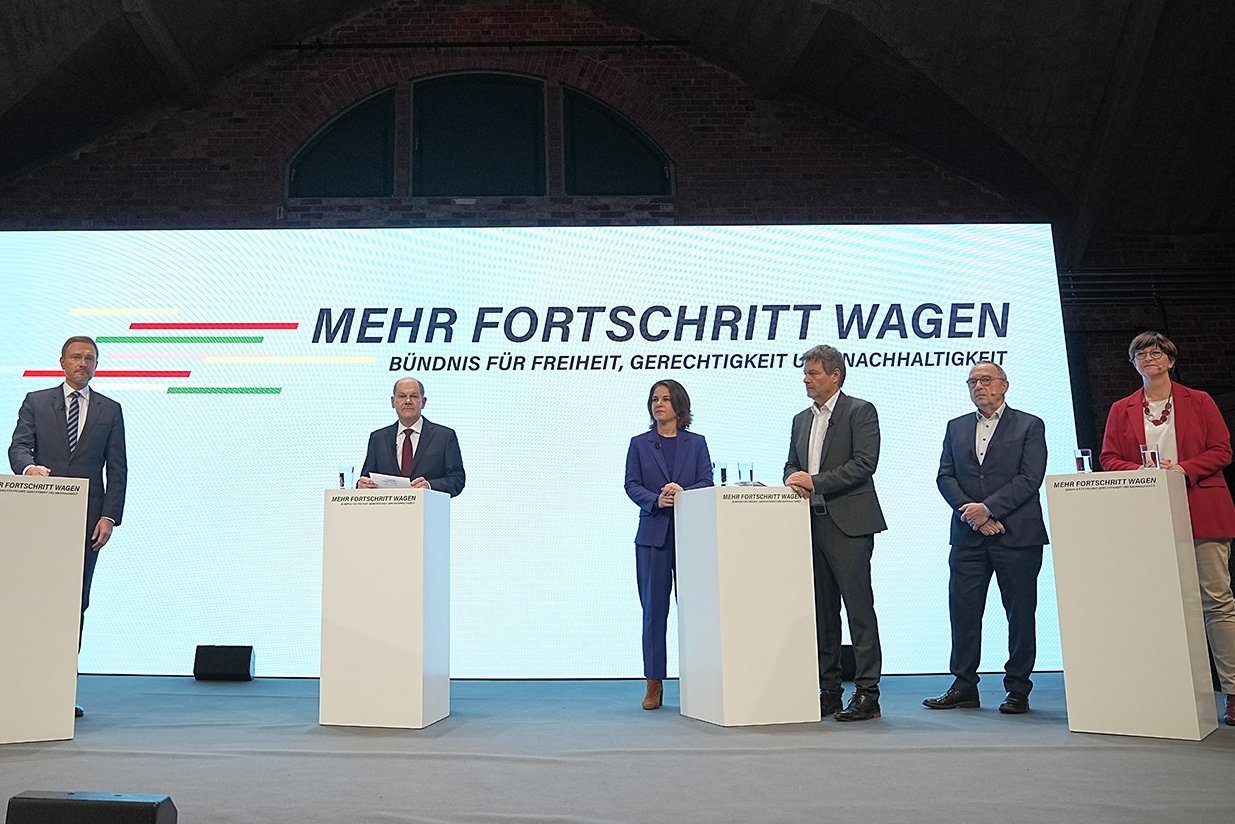
The new German government led by the social democrat Olaf Scholz wants to modernize the country and get rid of unnecessary bureaucracy. Everything has to move faster in a slow-paced Germany. Digitalization of public services is a priority. High-speed internet must be installed behind every household door. Investments in education and R&D are to increase substantially. These are some highlights of the coalition agreement between the SPD, FDP and the Greens, which was put together in just over a month.
The document spans 177 pages, with the section on a “modern state, a digital transition and innovations” featuring prominently at the beginning. Furthermore, as expected, the climate gets plenty of attention, then there is the housing shortage, raising the minimum wage and more security for children (material and immaterial).
Made in Germany
During the presentation of the coalition agreement, it became clear that the new government parties are all well aware that modernization must not be put on the back burner. Scholz, for example, said that Germany ought to place high value on “Spitzentechnologie, Made in Germany” when dealing with climate policy.
One of the Greens’ leaders, Robert Habeck, spoke of the importance of “a Germany that learns, and a politics that learns,” while the Liberal leader Christian Lindner spoke of a coalition that has its sights set on the future, that in addition to public money seeks to “unleash investment from the private sector.”
The title of the agreement says it all: “Mehr Fortschritt Wagen” it says on the cover. In other words, in 2021 it is not a time for sticking-plaster policies, but a time for action and “daring to go for progress”.
Difficult task
That this will not be easy is obvious to the new government parties. “Modernizing a country in times of crisis is an enormous task,” said Habeck. But according to Scholz, a very solid foundation has been laid for the next four years with this agreement. He compares the government of SPD, FDP and Greens – also known as Ampel, or the traffic light coalition – to the first German traffic light placed on Berlin’s Potsdamer Platz in 1924. “At first, people needed to get used to it, but it soon became second nature,” he said.
Scholz wants to use that comparison to show how revolutionary it is for Germany to have a coalition between Social Democrats, Liberals and Greens. That has never happened before.
10 days
In this respect, the coming days and weeks will be quite exciting. First of all, the agreement has to be submitted to the parties’ supporters. They must give their approval within 10 days. Then the search for suitable ministers will begin. So far, only the names of Scholz, Lindner (finance), Habeck (economic affairs and climate policy), Annalena Baerbock (foreign affairs), Volker Wissing (transport, FDP), Bettina Stark-Watzinger (education, FDP) and Marco Buschmann (justice, FDP) have been confirmed – and the agreement needs to be worked out in more detail on certain points.
In fact, it does not yet contain very many specific figures. The financial underpinnings, in particular, still need to follow. Some of the key points are:
- 400,000 new homes must be built each year, 100,000 of which will be co-financed by the government.
- The minimum wage will make a leap from the current level of just under 10 euros to 12 euros per hour.
- Coal-fired power plants are to be shut down sooner. However, the date is not yet firmly set. “Ideally” the closure of the last coal plant could take place in 2030 instead of 2038.
- Share of green electricity should have reached 80% in 2030, from now 50%.
- Investment in Research & Development (R&D) is going to ramped up and should reach a level of 3.5% of national income (GDP) by 2025.
- Germany has proven itself to be a center for biotechnology with the development of Biontech’s mRNA vaccine against corona. The government wants to boost this further. Among other things, there will be a new department at the Helmholz research institute, which will focus on age-related diseases such as Alzheimer’s.
- No amounts have yet been mentioned, but it is clear that more attention will be paid to start-ups and spin-offs. This concerns both money and support. In addition, starting up a company has to become easier.
- In the case of the electric car, the goal is to have 15 million fully electric cars on the roads by 2030. European battery projects will continue to be supported and Germany must develop itself into the innovative center for everything related to electromobility and self-driving cars.
- Ecological agriculture is the future according to the government partners. By 2030, the proportion must rise to 30 percent of the total.
- European cooperation will be sought in the field of green hydrogen.
- The Kreditanstalt für Wiederaufbau (KfW Bank) will continue to play a central role in financing innovations, infrastructure investments and start-ups. Ways in which the bank’s capital can be increased are still being explored.
- When it comes to R&D, there are a number of high-priority sectors. These include artificial intelligence (AI), quantum technology, cybersecurity and robotics. Here, too, European cooperation is desirable, including through the so-called Important Projects of Common European Interest (IPCEIs).
- The so-called Schuldenbremse (brake on government debt) will be upheld.
You can read the entire coalition agreement here (in German).
Also interesting:
How German political parties aim to combine climate and innovation after the Merkel era
German parliamentary elections are over. Now it’s “future policy” until the doctor arrives
Germany urgently needs to modernize in order to stay competitive
A video of the press conference is shown below:

